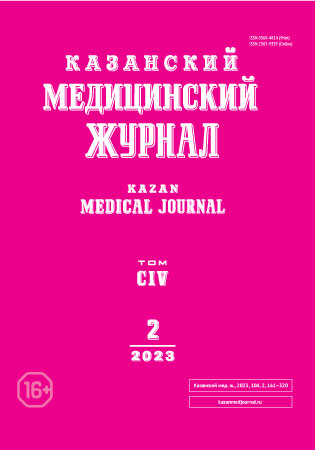Медико-социальные критерии прогнозирования трудового устройства инвалидов вследствие военной травмы
- Авторы: Нурова А.А.1
-
Учреждения:
- Санкт-Петербургский институт усовершенствования врачей-экспертов
- Выпуск: Том 104, № 2 (2023)
- Страницы: 274-282
- Раздел: Социальная гигиена и организация здравоохранения
- Статья получена: 02.11.2022
- Статья одобрена: 27.12.2022
- Статья опубликована: 26.03.2023
- URL: https://kazanmedjournal.ru/kazanmedj/article/view/112296
- DOI: https://doi.org/10.17816/KMJ112296
- ID: 112296
Цитировать
Полный текст
Аннотация
Актуальность. Трудоустройство и занятость — важные направления социальной политики в системе реабилитации инвалидов. Военнослужащие в трудоспособном возрасте представляют собой активную и работоспособную часть населения, однако при установлении инвалидности у них формируются проблемы, связанные с социальной дезадаптацией.
Цель. Разработка критериев оценки социально-трудового прогноза инвалидов военной службы по причине «военная травма».
Материал и методы исследования. Проведено поперечное исследование методом случайного бесповторного отбора. Из совокупности 1618 инвалидов по причине «военная травма», проходивших повторное освидетельствование в бюро медико-социальной экспертизы Республики Дагестан в период 2014–2019 гг., была сформирована выборочная совокупность военнослужащих с инвалидностью по последствиям военной травмы (n=90), которые были разделены на две группы. Критерием деления на группы была мотивация к трудовой деятельности. Первая группа включала 28 инвалидов, которые работали после установления им инвалидности и характеризовались положительной мотивацией к труду. Вторая группа включала 62 инвалидов, которые на момент обследования не работали и характеризовались отрицательной и неопределённой мотивацией к труду. Инвалиды обеих групп были подвергнуты анкетированию по разработанной нами оригинальной анкете «Медико-экспертные показатели жизнедеятельности инвалидов военной службы по причине «военная травма», характеризующие состояние жизнедеятельности и потребности инвалидов вследствие военной травмы». Проведён сравнительный статистический анализ выделенных групп по комплексу социально-гигиенических показателей военнослужащих с инвалидностью по причине «военная травма» методом проверки статистических гипотез с использованием непараметрических критериев χ2 Пирсона и точного критерия Фишера. Ранжирование изученных показателей по степени их влияния на результат трудоустройства выполнено с помощью алгоритма деревьев классификации. Выделена совокупность 7 признаков, наиболее тесно связанных с результатом трудоустройства, которые были использованы для вычисления показателя социально-трудового прогноза. Вычисленное пороговое значение показателя социально-трудового прогноза позволило дискриминировать военнослужащих с инвалидностью по причине «военная травма» на две группы, ассоциированные с высокой и низкой возможностью трудоустройства.
Результаты. Длительность пребывания на инвалидности от 1 до 4 лет характеризовало более половины работающих инвалидов и только четверть неработающих (64,3 и 22,6% соответственно; χ2=14,64; р <0,001); от 5 до 10 лет находились на инвалидности 21,4% работающих инвалидов и в 2 раза бóльшая доля (45,2%) неработающих (χ2=4,62; р=0,032). В группе работающих у подавляющего большинства (92,9%) были чёткие представления о необходимости труда для восстановления своего здоровья, чего нельзя было сказать про инвалидов группы неработающих (27,4%; χ2=33,1; р <0,001). Установлена значимая сопряжённость мотивации к труду с возрастной структурой инвалидов вследствие военной травмы. Самая молодая возрастная категория (18–39 лет) в 67,9% случаев была характерна для инвалидов с положительной мотивацией к труду, в то время как в группах с неопределённой и отрицательной мотивацией встречалась статистически значимо реже — 26,7 и 6,5% (р=0,0017 и р <0,001 соответственно). Установлена сопряжённость между мотивацией к труду и оценкой своих трудовых возможностей: 67,9% с положительной установкой на труд характеризовались адекватной самооценкой, что отличало эту группу от двух других (р <0,001). Выявлены значимые различия в структуре выраженности их психоорганического синдрома. Выраженная степень психоорганического синдрома определялась у каждого четвёртого инвалида с отрицательной мотивацией к труду (25,0%), в то время как у инвалидов с положительной и неопределённой мотивацией отсутствовала (р <0,01).
Вывод. Наиболее приоритетными показателями, участвующими в формировании социально-трудового прогноза, оказались длительность инвалидности, мотивация к труду, возраст, степень выраженности психоорганического синдрома, самооценка профессиональных способностей, проведение своевременной проф¬ориентационной и информационной работы с инвалидами, ограничение способности в самообслуживании.
Ключевые слова
Полный текст
Об авторах
Аминат Алиевна Нурова
Санкт-Петербургский институт усовершенствования врачей-экспертов
Автор, ответственный за переписку.
Email: amina1968nurova@mail.ru
ORCID iD: 0000-0002-6585-3966
аспирант, каф. организации здравоохранения, МСЭ и реабилитации
Россия, г. Санкт-Петербург, РоссияСписок литературы
- Владимирова О.Н., Афонина К.П., Пономаренко Г.Н., Шошмин А.В. Организация системы комплексной реабилитации в Российской Федерации на основе изучения потребностей инвалидов. Медицина в Кузбассе. 2018;(4):20–27. EDN: YOWKVF.
- Карасаева Л.А. Организационные и правовые проблемы в системе профессиональной реабилитации инвалидов. Поиск путей их решения. В кн.: Реабилитация — 21 век. Традиции и инновации. СПб.; 2021. с. 72–76. https://cipo.omkpt.ru/wp-content/uploads/2021/12/сборник-Congress2021.pdf (дата обращения: 16.10.2022).
- Дымочка М.А., Андреева О.С., Морозова Е.В. Нуждаемость в комплексной реабилитации лиц, впервые признанных инвалидами из числа взрослого населения Российской Федерации, за период 2016–2018 гг. Медико-социальные проблемы инвалидности. 2020;(2):61–66. EDN: TKUTXF.
- Официальный сайт. Федеральная государственная информационная система. Федеральный реестр инвалидов. https://sfri.ru/analitika/chislennost/chislennost (дата обращения: 01.11.2022).
- Старобина Е.М., Владимирова О.Н., Давыдов А.Т., Разумовский М.И., Кожушко Л.А. Факторы, определяющие трудовую деятельность инвалидов со значительными нарушениями здоровья. Медико-социальная экспертиза и реабилитация. 2017;20(1):19–24. doi: 10.18821/1560-9537-2017-20-1-19-24.
- Карасаева Л.А., Горяйнова М.В., Нурова А.А. Организационно-правовые основы трудового устройства инвалидов в современных условиях. Вестник Всероссийского общества специалистов по медико-социальной экспертизе, реабилитации и реабилитационной индустрии. 2020;(1):31–40. doi: 10.17238/issn1999-2351.2020.1.31-40.
- Шакирзянова Ю.А. Поддерживаемое трудоустройство как альтернативная форма традиционной трудовой занятости лиц с инвалидностью в России. Новая наука: От идеи к результату. 2016;(6-2):65–68. EDN: UATUUC.
- Фадин Н.И. Экономические аспекты трудовой занятости инвалидов. Инновации и инвестиции. 2016;(4):79–82. EDN: WRJEVV.
- Андреева О.С., Карасаева Л.А., Шкурко М.А., Науменко Л.Л. Показатели инвалидности военнослужащих в трудоспособном и пенсионном возрасте за 2015–2016 гг. (территориальный аспект). Вестник Российской военно-медицинской академии. 2018;(3):193–195. EDN: ZCZCDJ.
- Чикинова Л.Н., Гришина Л.П. Состояние инвалидности у бывших военнослужащих и пути совершенствования деятельности учреждений медико-социальной экспертизы по их освидетельствованию. Медико-социальные проблемы инвалидности. 2013;(4):75–77. EDN: TAXXXV.
- Конвенция о правах инвалидов. Принята Резолюцией Генеральной Ассамблеи ООН от 13.12.2006 №61/106 (сост. на 26.10.2012). М.; 2012. 29 с.
- Федеральный закон РФ «О внесении изменений в отдельные законодательные акты Российской Федерации по вопросам социальной защиты инвалидов в связи с ратификацией Конвенции о правах инвалидов» от 01.12.2014. №419-ФЗ. http://www.consultant.ru/document/cons_doc_LAW_171577/ (дата обращения: 16.10.2022).
- Приказ Минтруда России «О классификациях и критериях, используемых при осуществлении медико-социальной экспертизы граждан федеральными государственными учреждениями медико-социальной экспертизы» от 7 августа 2019 г. №585н. https://normativ.kontur.ru/ (дата обращения: 31.01.2023)
Дополнительные файлы









